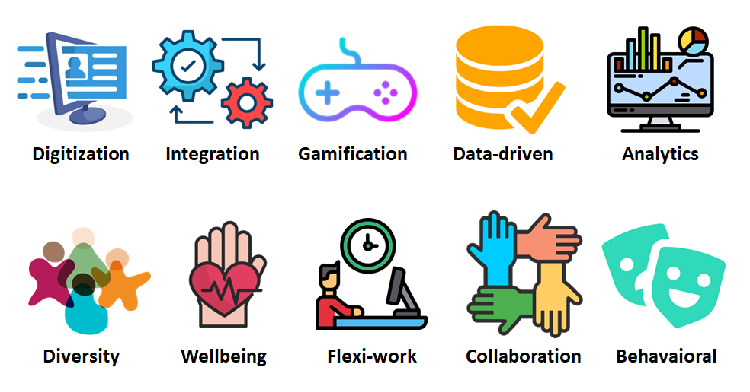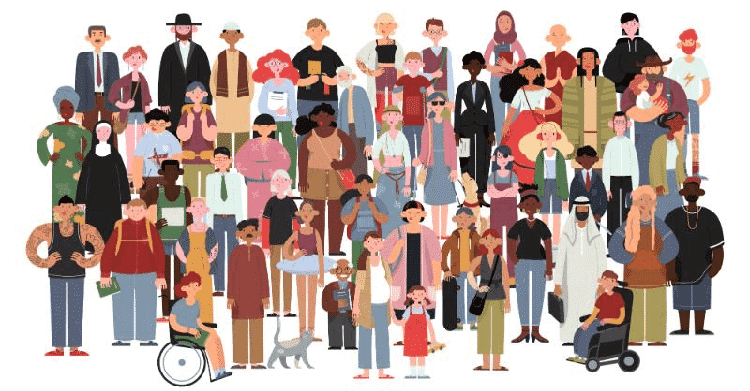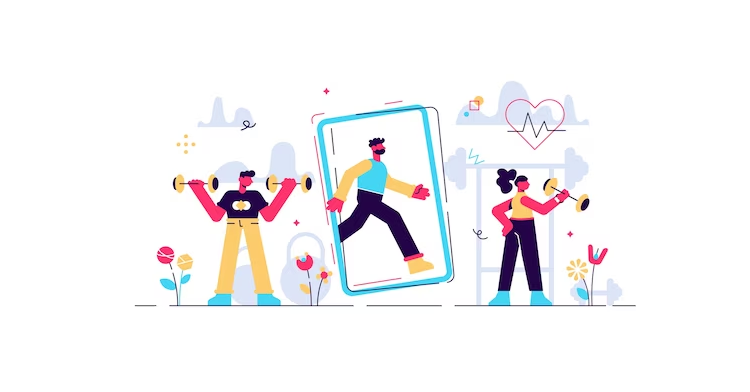
1. Digitization and Integration: Organizations are increasingly digitizing recognition programs and embedding them into existing platforms to streamline processes and improve accessibility, especially for remote and hybrid workforces.
2. Focus on Employee Wellbeing and Flexibility: Recognition programs integrate employee wellness, mental health, and work flexibility, emphasizing holistic support for employee satisfaction.
3. Diversity and Inclusion: Recognition programs are evolving to promote gender-neutral, inclusive practices, ensuring fair rewards based on contribution rather than gender or other biases.
4. Gamification and Data-Driven Strategies: Recognition is becoming more engaging through gamification (leaderboards, badges) while leveraging data analytics to ensure fairness, transparency, and effectiveness in recognizing employee achievements.
With rapid changes in the business, economy, and technology, employee recognition is one level that organizations can use to drive workforce performance and culture. Hence, understanding critical trends for employee recognition in 2023 is vital for them.
The accelerated evolution of digital workplaces over the last few years due to the pandemic has also made organizations and employees rethink their priorities regarding their workforce.
This has catapulted the need to recognize the good work and positive behaviors of employees, in a timely and effective manner, to the forefront.

It is essential to keep the employees motivated and engaged, build a positive and flexible work culture, and boost collaboration among the workforce.
Studies have shown that highly engaged and motivated employees are 21% more productive and businesses experience a 41% decrease in employee absenteeism.

Employee recognition contributes significantly to strengthening the commitment and loyalty of the employees and enhancing their productivity.
A highly productive workforce naturally helps enhance the profitability of the organization.
Also read: How Employee Recognition Can Drive Culture Change in 2023
The very concept of employee recognition has evolved significantly over the past several years.
Today, it is not just about providing employees with the right rewards for their excellent work.
Rather it is more focused on enhancing the overall employee experience and their well-being at the workplace.
Now, recognition is about acknowledging the employees’ individuality and helping positively redefine their relationship with work and its impact on their lives.

Employees today view recognition as much more than getting a better work-life balance, enhanced job security, increased pay and benefits, or even value alignment.
They are questioning the fundamentals of the organizations they work for and redefining the importance of work in their lives.
This has led them to seek more human-centric employee rewards and recognition programs that will help them thrive and survive in today’s volatile business environments.
The constant upheavals businesses have faced over the last few years have impacted how they recognize their employees.
With the sudden shift to remote working and the evolution of hybrid work environments, traditional recognition methodologies have become obsolete.
In addition, the ongoing economic and social changes have also changed how employees today perceive rewards and recognition.
It has created a greater demand for holistic rewards and recognition policies that enhance employee happiness and satisfaction levels at the workplace.

Employees today are seeking more value-oriented recognition from their employees.
They are now more focused on having workplace experiences that positively impact their personal and professional lives.
This can be better understood by the fact that employees today value receiving non-monetary recognition for their good work by their superiors and peers more than receiving a significant monetary reward six months or even a year down the line.
For most employees today, the ability of their employers to recognize their need to get some additional time with family is worth more than any memento or award they might be offered.
With 2022 ending, it is time for business organizations to review their existing recognition policies and revamp them for 2023.
For this, organizations need to gain a proper understanding of the emerging key trends for employee recognition in 2023.

Awareness of these trends proves highly beneficial for organizations looking to take their business to new heights of success in the coming year.
This is due to the following reasons:
Having understood the importance of staying updated about the Key Trends for Employee Recognition in 2023, it is time to learn more about them.
The key trends that organizations need to look out for in the coming year include the following:
1. Acceleration in Digitization Of Recognition
2. Embedding Recognition Capability In Existing Platforms
3. Increased Gamification Of Recognition
4. Implementing Data-Driven Recognition Strategy
5. Greater Focus On Analytics
6. Promoting Diversity And Inclusion Through Recognition
7. Employee Wellbeing Through Recognition
8. Work Flexibility As Employee Rewards
9. Driving Collaboration Through Recognition
10. Recognizing Positive Behavior


Digitization of the recognition programs is essential for making them acceptable to the modern workforce.
Using the right employee recognition software helps make the process simpler and more relevant for digitally-driven Gen Z employees, who form a major section of the workforce today.
Digitizing recognition programs also helps promote peer-to-peer recognition and makes it easier for managers and supervisors to offer on-the-spot recognition.
It also makes recognition of remote-working employees more effective and efficient, which boosts their sense of belonging and commitment.
Most importantly, digitizing recognition makes it highly cost-effective and easy to implement.

Organizations must ensure that the recognition capability is embedded in their platforms.
This ensures managers and supervisors can continue recognizing employees without navigating to the dedicated recognition platform.
Making it possible to trigger employee recognition from the existing systems such as chatbots, collaboration tools, CRM, LMS, and other platforms enhances the cost-effectiveness of the process besides making it simpler to implement and use.
Employees and managers do not need to invest time and effort in familiarizing themselves with the technical aspects of the new recognition platform.
Embedding recognition capability in existing systems also helps increase the scalability of the programs to meet the changing workforce needs.

An effective employee recognition platform is insufficient to retain employee interest in the program.
Employees are increasingly looking for highly interactive and engaging recognition programs that pique their curiosity and retain their interest.
Integrating gamification techniques in the recognition program is an effective way to ensure this.
Implementing gamification mechanisms such as leaderboards, reward points, recognition through e-cards, offering badges, etc. can help make recognition fun-filled and interactive.
Such initiatives help to keep the employees motivated and contribute towards building a competitive yet healthy work environment.

Ensuring greater transparency in the recognition program is another critical trend that organizations should focus on in 2023.
This is essential to establish the program’s authenticity and improve the employee participation rate.
For this, organizations need to make sure that they follow a data-driven recognition strategy to ensure that only the most deserving are recognized.
Implementing such a recognition strategy will help to streamline the recognition process and make it more impactful and valid.
It also helps eliminate any favoritism or bias in the recognition process, which improves workforce engagement and motivation.

Implementing people analytics technology as a part of their recognition policies can significantly boost business productivity.
These technologies offer businesses data-driven insights into the skills and competence of the workforce.
This makes it easier for organizations to create effective recognition strategies based on their competence and skills that can help enhance employee performance.
By paying greater attention to people analytics technology, organizations can devise recognition policies and methodologies that are employee-centric.
It enables the creation of personalized recognition plans that can boost employee happiness and workplace experience.

Women form a significantly large part of the modern workforce.
That is why it is high time for organizations to modify their male-centric work policies, including those related to recognition, to make them more gender-neutral and inclusive.
For this, organizations need to implement a fair and uniform reward and appreciation policy based on the role and contribution of the employees rather than their gender.
Organizations need to offer to eliminate any bias in providing professional growth opportunities as a way of recognizing employees.
This will enable more women to compete for higher leadership positions and give them opportunities to participate in the decision-making process.

In the aftermath of the pandemic, employees have been seeking better wellness support from their employers.
This trend will likely continue in the coming year, so organizations need to pay greater attention to including wellness benefits in their employee recognition programs.
Making wellness an integral part of the recognition policy is key to enhancing the happiness and satisfaction level of the employees.
Businesses should consider offering wellness rewards such as gym or fitness club memberships and providing access to quality medical care and online consultation facilities for employees and their families.
Creating a safe work environment and supporting employees’ mental and emotional well-being at the workplace is essential.

Organizations have often overlooked the importance of offering greater flexibility in terms of work hours to their employee.
Even though some organizations used flexible work schedules for a limited period as a way of recognizing the good work of employees, implementing this strategy on a large scale was unthinkable.
However, as the pandemic forced employees to work remotely and follow flexible work schedules, businesses became increasingly aware of the benefits of following this strategy.
In the post-pandemic world, work flexibility continues to be a fundamental recognition need for most employees.
That is why organizations should offer employees the option of remote or hybrid working to recognize their efforts and achievements.

Working towards creating more collaborative and agile work environments is yet another aspect of employee recognition that businesses need to focus on in 2023.
Doing so helps to build a pleasant workspace where employees feel less stressed and enjoy completing the tasks assigned to them.
Rewarding the collective efforts of groups of employees, teams, and even work groups is the best way to promote a collaborative work environment.
It helps build trust between employees and also strengthens the camaraderie between coworkers.
A collaborative work environment promotes peer-to-peer recognition.

Many employees today seek to uphold their individuality in the workplace.
Fulfilling this basic need of employees can enable organizations to build a highly committed and motivated workforce.
Recognizing positive employee behaviors that contribute to business growth is an effective way of fulfilling this need.
It helps assure the employees that they are cared for and understood as human beings rather than just business assets.
This, in turn, motivates them to continue giving their best by leveraging individual employees’ specific strengths and capabilities.
Staying updated about the key trends for employee recognition in 2023 can provide businesses with a great competitive advantage. Organizations can on those trends that are likely to be most beneficial for them to build a more productive workforce.

Lead author: Sagar Chaudhuri, the Co-Founder and CEO of HiFives. He is an HR Tech Evangelist with over 25 years of corporate and entrepreneurship experience. In the past, Sagar has worked in leadership roles with companies such as Genpact, Infosys, and ICICI Bank. He has an engineering degree from IIT Kharagpur and an MBA from IIM Lucknow. Connect on LinkedIn
To stay updated on the latest HiFives blogs, follow us on Twitter (@MyHiFives)